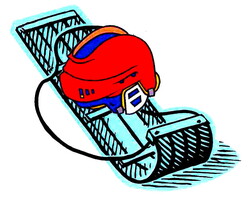
Find Out More
Parents & Educators
Parents and Educators:
Clothing:
- Dress children in several layers of clothing. If they get too warm, they can remove one layer at a time.
- Always remove children’s wet clothing and boots immediately.
- Make sure children wear a hat because most body heat is lost through the head.
- Have children keep their ears covered at all times to prevent frostbite.
- Have children wear mittens instead of gloves.
- Dress children in warm, waterproof boots that are roomy enough to wiggle their toes around.
- Remove all drawstrings from children’s clothing to prevent strangulation. Use Velcro or other fasteners instead and use a neck warmer instead of a scarf.
Skating:
- Make sure children always wear a hockey or ski helmet while skating.
- Make sure children’s skates are comfortable, with good ankle support, to avoid twists, sprains, and breaks.
- When possible, have children skate on public indoor or outdoor rinks. If this is not possible, children should remember to:
- Obey all signs posted on or near the ice. Yellow signs usually mean skate with caution, and red usually means no skating allowed.
- Make sure they are always supervised on the ice.
- Never assume it’s safe to skate on a lake or pond. An adult should make sure the ice is at least 10 cm (four inches) thick, and check with local weather authorities for information about ice thickness.
- Avoid walking on ice near moving water. Ice formed on moving water, such as rivers and creeks, will vary in thickness and is highly unpredictable.
Sledding:
Children should:
- Always wear either a ski or hockey helmet — not a bicycle helmet — while sledding.
- Never use a sled with sharp or jagged edges.
- Make sure the handholds on the sled are secure.
- Always sit up or kneel on a sled. Lying down increases the risk of head, spine and abdominal injuries.
- Never sled on or near roadways.
- Look for shallow slopes that are free of trees, fences, or any other obstacles.
- Avoid sledding on crowded slopes.
- Use a “steerable” sled.
Skiing/snowboarding:
Children should:
- Take lessons from a qualified skiing or snowboarding instructor.
- Never ski or snowboard alone.
- With parents, check equipment every year for fit and maintenance. Bindings should be checked annually by a qualified technician.
- Make sure they’re in control of their speed. Many injuries result from a loss of control. Stunts and fatigue also lead to injuries.
- Always wear a helmet with side vents that allow them to hear.
- When snowboarding, wear wrist guards to reduce the risk of wrist injury.
- Dress safely. Wear bright-coloured clothing, and warm hats and mittens.
- Avoid ice hills. The risk of falls and injuries increases in icy conditions.
- Watch out for other skiers and snowboarders, as well as any other obstacles, on the slopes.
- Stay in designated areas and on marked trails.
*With lessons from a certified instructor, it’s okay for younger children to snowboard; however, their coordination is not fully developed until the age of 10. Reference: Canadian Association of Snowboard Instructors


